
When Is The Best Time To Treat Leg Veins?
As the better weather appears through Spring and Summer, it is the time of year that shorts, dresses and swimwear come out and unsightly leg veins are exposed again. This is the commonest time of year that people think about having treatments to improve the appearance of their legs, but is it the best time of year to have these veins treated?
We often get asked “When is the best time to treat my leg veins?” The answer of course depends on individual circumstances. As a general rule, the best time to treat your veins is when they reach a point they worry you enough to justify the necessary treatment.
Leg veins can be an issue because of how they look, how they feel, possible future problems related to the leg veins or a combination of these concerns.
HOW THEY LOOK
It is important to understand that unsightly leg veins, especially widespread Spider Veins, can take several treatments to achieve the best clearance. The number of treatments varies with how severe the Spider Veins are and the desired level of improvement, but it is common to need at least 4 treatments. When you factor in that treatments are usually 4 weeks apart, then to achieve your best looking legs for the hot weather, means treatment should ideally start well before summer. However, does that mean now waiting and doing nothing until next winter? as that would mean another summer of ugly legs.
Many patients with unsightly leg veins are keen to at least start treatment as soon as possible, as they figure that some improvement is better than none. Most patients being treated for unsightly leg veins have noticeable improvement after 2 treatments and it is common that patients try and get at least a couple of treatments in before summer.
Some patients may then wait until after the hot weather to finish their course of treatment whilst others continue treatment through summer. It is personal preference and often depends on how much bruising occurs with treatment and the need for stockings after treatment, especially how long they have to be worn.
HOW THEY FEEL
Leg veins can cause symptoms and these can vary from minor vague heaviness and tightness to significant burning, cramping, pain and swelling. Leg vein symptoms are typically much worse in the hot weather and this is another reason patients seek to have treatment at this time of year. However, the treatment of deep or large Varicose Veins requires compression stockings for at least a week after treatment and it is usually advised to avoid long distance plane flights for several weeks, which could be during the time many people have their holidays.
Generally the larger the veins on the surface of the skin the more likely they are to cause symptoms, but this is definitely not always the case. We have patients with huge Varicose Veins that don’t have any symptoms at all whilst others with only small Spider Veins can have significant symptoms. The latter can be an indication that there are underlying deeper vein issues that are not obvious when just looking at the legs. This is why the use of diagnostic equipment, like Ultrasound scans, to work out what is going on below the surface is so important in assessing leg veins.
FUTURE PROBLEMS
Some patients are concerned about their leg veins, not so much because of how they currently are, but because of how bad they may become. They want to treat their leg veins before they get worse as a preventative measure. This proactive approach has to be balanced against the fact that in most patients, whether you treat your leg veins or not now, more veins will develop in the future. On balance though, treating leg veins before they become more severe, requires simpler or fewer treatments and also getting your leg veins under control will slow the rate at which new veins develop. So the early treatment of leg veins is a good idea.
Other patients are worried about potential health problems their veins might cause them in the future and want to try and prevent this happening. It is quite common that patients know of a relative or friend that has had leg vein complications such as a deep vein thrombosis (DVT), swelling that required continuous use of stockings or leg ulcers that wouldn’t heal. Certainly leg veins can sometimes cause significant problems in the future but the risk of this is not the same for everyone and the risk assessment of potential future problems is part of the Leg Vein Consultation when we first see a patient.
ASSESSMENT SOONER THAN LATER
So in answer to the question of when is the best time to treat unsightly and/or painful leg veins, we say the sooner you get your veins assessed and a treatment plan organised the better. Getting your leg veins under control sooner rather than later and then maintenance treatments in the future, if necessary, is the best management plan. It depends on the proposed treatment and individual circumstances as to when the best time to do that is.

Leave a Reply